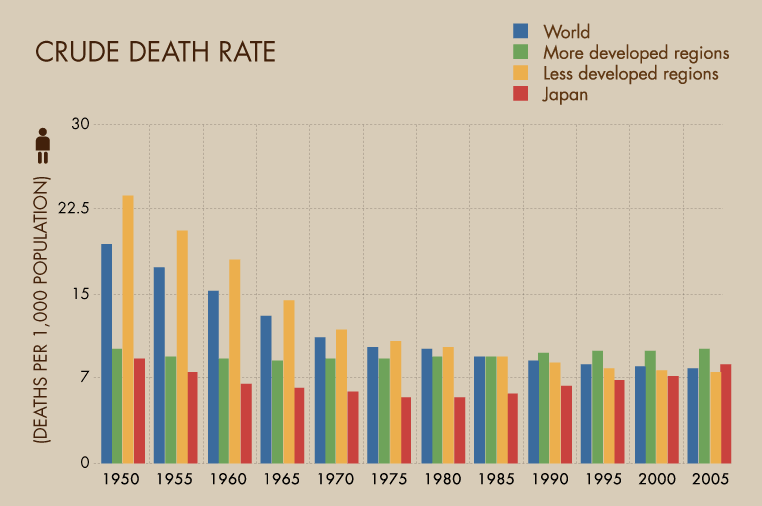The crude death rate (CDR) is a pivotal demographic measure that gives insight into the mortality trends of a population. It serves as a fundamental tool for researchers, policymakers, and public health officials to assess the health status of communities and nations. By understanding the crude death rate definition, we can delve into its implications on population dynamics and social planning.
In essence, the crude death rate is calculated as the number of deaths in a given year per 1,000 people in the population. This statistic is crucial in understanding not only the mortality patterns within a population but also for evaluating the effectiveness of health interventions over time. Knowing the crude death rate helps in drawing comparisons between different regions and historical periods, thus shaping public health strategies.
The significance of the crude death rate transcends mere numbers. It reflects the overall health conditions, lifestyle factors, and healthcare accessibility within a society. As we engage with the crude death rate definition, we can uncover the various factors contributing to changes in mortality rates and how they can inform future health policies. This article aims to explore the intricacies of the crude death rate, its calculation, significance, and its role in shaping public health narratives.
What is the Crude Death Rate Definition?
The crude death rate is defined as the total number of deaths occurring in a given year divided by the total population at mid-year, multiplied by 1,000. This measurement provides a straightforward way to understand mortality in a population without adjusting for age or sex differences.
How is Crude Death Rate Calculated?
The calculation of the crude death rate can be simplified into the following formula:
- CDR = (Number of Deaths / Total Population) x 1,000
For example, if a country has 500 deaths in a year and a total population of 100,000, the crude death rate would be:
- CDR = (500 / 100,000) x 1,000 = 5
Why is the Crude Death Rate Important?
The crude death rate plays a pivotal role in various fields including:
- Public Health: It helps inform health policies and resource allocation.
- Demography: It aids in understanding population trends and projections.
- Economics: Mortality rates influence productivity and economic growth.
What Factors Influence Crude Death Rates?
Several factors can influence the crude death rate, including:
- Age Distribution: Older populations typically have higher death rates.
- Healthcare Access: Improved healthcare can lower mortality rates.
- Socioeconomic Status: Poverty can lead to higher death rates due to limited resources.
- Environmental Factors: Pollution and living conditions can affect health outcomes.
How Does the Crude Death Rate Compare to Other Mortality Rates?
While the crude death rate provides a basic understanding of mortality, it is essential to compare it with:
- Age-Specific Death Rates: These rates focus on specific age groups, offering more detailed insights.
- Cause-Specific Death Rates: These rates highlight the mortality risk associated with specific diseases or conditions.
- Infant Mortality Rate: This rate focuses on deaths of infants, critical for assessing child health.
What Are the Limitations of the Crude Death Rate?
Despite its usefulness, the crude death rate has limitations:
- It does not account for the age or sex structure of a population.
- It may not reflect the health conditions of specific subpopulations.
- It can be influenced by external factors such as natural disasters or epidemics.
How Can Crude Death Rate Data Be Used?
Data on the crude death rate can be utilized in several ways:
- Policy Development: To create targeted public health initiatives.
- Resource Allocation: To prioritize healthcare resources in high-mortality areas.
- Research: To study the impacts of various interventions on health outcomes.
What is the Global Trend in Crude Death Rates?
Globally, crude death rates have been influenced by various factors such as:
- Advancements in medical technology and healthcare.
- Changes in lifestyle and environmental conditions.
- Impact of global pandemics, such as COVID-19, on mortality rates.
Monitoring these trends allows countries to adjust their health strategies accordingly and prepare for future challenges.
Conclusion: The Significance of Understanding Crude Death Rate Definition
In conclusion, the crude death rate definition is a vital statistical measure that aids in understanding mortality within populations. By examining the factors that influence crude death rates and recognizing its limitations, stakeholders can make informed decisions that impact public health strategies and resource allocation. As societies continue to evolve, keeping a close eye on crude death rate trends will be essential for promoting health and improving the quality of life for all residents.
Unlocking The Power Of The Psql Command: A Comprehensive Guide
Understanding The Role Of Spark.executor.instances In Apache Spark
Understanding The Richness Of Bittersweet Chocolate


